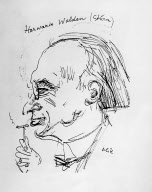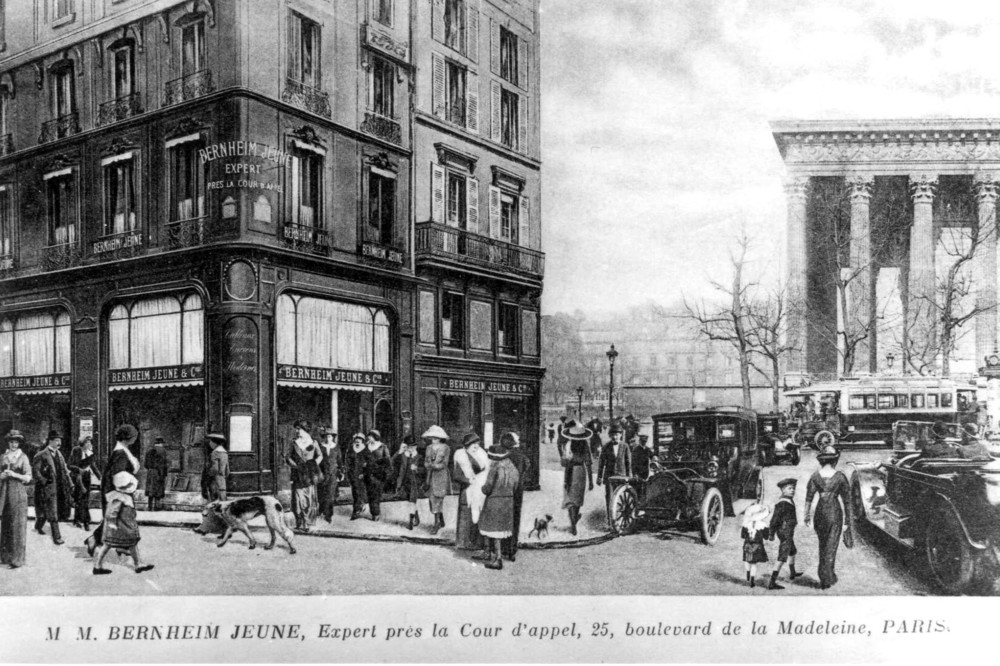|
The Street Enters The House
''The Street Enters the House'' (''La Strada Entra Nella Casa'') is an oil on canvas painting by Italian artist Umberto Boccioni. Painted in the Futurist style, the work centres on a woman on a balcony in front of a busy street, with the sounds of the activity below portrayed as a riot of shapes and colours. The first public display of the painting was in Paris, in 1912, as part of the first Futurist exhibition. It is now housed in the Sprengel Museum in Hanover, Germany. Background Boccioni was one of the founding members of the Futurist movement. Until 1910, the group concentrated primarily on capturing "emotion and multiple states of mind" using techniques derived from Neoimpressionism style (for example, Severini's '' The Black Cat'' or '' The Obsessive Dancer''). After hearing second-hand reports of the innovations of Picasso and Braque, Boccioni and his compatriots adapted their technique to match, incorporating angular lines and intersecting planes as a way of capturin ... [...More Info...] [...Related Items...] OR: [Wikipedia] [Google] [Baidu] |
Italian Language
Italian (''italiano'' or ) is a Romance language of the Indo-European language family that evolved from the Vulgar Latin of the Roman Empire. Together with Sardinian, Italian is the least divergent language from Latin. Spoken by about 85 million people (2022), Italian is an official language in Italy, Switzerland (Ticino and the Grisons), San Marino, and Vatican City. It has an official minority status in western Istria (Croatia and Slovenia). Italian is also spoken by large immigrant and expatriate communities in the Americas and Australia.Ethnologue report for language code:ita (Italy) – Gordon, Raymond G., Jr. (ed.), 2005. Ethnologue: Languages of the World, Fifteenth edition. Dallas, Tex.: SIL International. Online version Itali ... [...More Info...] [...Related Items...] OR: [Wikipedia] [Google] [Baidu] |
The City Rises
''The City Rises'' (''La città che sale'') (1910) is a painting by the Italian painter Umberto Boccioni. It was his first major Futurist work. Background The original title of the painting was ''Il lavoro'' (''Work''), as it appeared at the ''Mostra d'arte libera'' (Exhibition of free art) in Milan in 1911. Though realistic elements are present, such as the building, and the space is still rendered through perspective, this painting is considered the first true futurist work by Umberto Boccioni, even though it is not markedly different from his several previous works centered on suburbs. In this painting the naturalistic vision of the previous works is partly abandoned, replaced by a more dynamic vision. Subject Buildings in construction in a suburb can be seen with chimneys in the upper part, but most of the space is occupied by men and horses, melted together in a dynamic effort. Boccioni thus emphasizes some of the most typical elements of futurism, the exaltation of human ... [...More Info...] [...Related Items...] OR: [Wikipedia] [Google] [Baidu] |
Herwarth Walden
Herwarth Walden (actual name Georg Lewin; 16 September 1879, in Berlin – 31 October 1941, in Saratov, Russia) was a German expressionist artist and art expert in many disciplines. He is broadly acknowledged as one of the most important discoverers and promoters of German avant-garde art in the early twentieth century (Expressionism, Futurism, Dadaism, Magic Realism). He was best known as the founder of the Expressionist magazine ''Der Sturm'' (The Storm) and its offshoots. Biography He studied composition and piano at the music academies of Berlin and Florence. However, his interest embraced all arts. So he became a musician, composer, writer, critic, and gallery owner. He was best known as the founder of the expressionist magazine ''Der Sturm'' (The Storm) and its offshoots. These consisted of a publishing house and journal, founded in 1910, to which he added an art gallery two years later. He discovered, sponsored and promoted many young, still unknown artists of different s ... [...More Info...] [...Related Items...] OR: [Wikipedia] [Google] [Baidu] |
Carlo Carrà
Carlo Carrà (; February 11, 1881 – April 13, 1966) was an Italian painter and a leading figure of the Futurist movement that flourished in Italy during the beginning of the 20th century. In addition to his many paintings, he wrote a number of books concerning art. He taught for many years in the city of Milan. Biography Carrà was born in Quargnento, near Alessandria (Piedmont). At the age of 12 he left home in order to work as a mural decorator. In 1899–1900, Carrà was in Paris decorating pavilions at the Exposition Universelle, where he became acquainted with contemporary French art. He then spent a few months in London in contact with exiled Italian anarchists, and returned to Milan in 1901. In 1906, he enrolled at Brera Academy (''Accademia di Brera'') in the city, and studied under Cesare Tallone. In 1910 he signed, along with Umberto Boccioni, Luigi Russolo and Giacomo Balla the ''Manifesto of Futurist Painters'', and began a phase of painting that became his mo ... [...More Info...] [...Related Items...] OR: [Wikipedia] [Google] [Baidu] |
Bernheim-Jeune
Bernheim-Jeune gallery is one of the oldest art galleries in Paris. Opened on Rue Laffitte in 1863 by Alexandre Bernheim (1839-1915), friend of Delacroix, Corot and Courbet, it changed location a few times before settling on Avenue Matignon. The gallery promoted realists, Barbizon school paintings and, in 1874, the first impressionist and later post-impressionist painters. It closed in 2019. History In 1901, Alexandre Bernheim, with his sons, Josse (1870-1941), and Gaston (1870-1953), organized the first important exhibition of Vincent van Gogh paintings in Paris with the help of art critic Julien Leclercq. In 1906, ''Bernheim-Jeune frères'' started presenting works by Pierre Bonnard, Édouard Vuillard, Paul Cézanne, Henri-Edmond Cross, Kees van Dongen, Henri Matisse, Le Douanier Rousseau, Raoul Dufy, Maurice de Vlaminck, Amedeo Modigliani, Maurice Utrillo and Georges Dufrénoy. From 1906 to 1925, art critic Félix Fénéon was the director of the gallery and was instrum ... [...More Info...] [...Related Items...] OR: [Wikipedia] [Google] [Baidu] |
Thames And Hudson
Thames & Hudson (sometimes T&H for brevity) is a publisher of illustrated books in all visually creative categories: art, architecture, design, photography, fashion, film, and the performing arts. It also publishes books on archaeology, history, and popular culture. Headquartered in London, it has a sister company in New York City, and subsidiaries in Melbourne, Singapore, and Hong Kong. In Paris it has a sister company, Éditions Thames & Hudson, and a subsidiary called Interart which distributes English-language books. The Thames & Hudson group currently employs approximately 150 staff in London and approximately 65 more around the world. The publishing company was founded in 1949 by Walter and Eva Neurath, who aimed to make the world of art and the research of top scholars available to a wider public. The company's name reflects its international presence, particularly in London and New York. It remains an independent, family-owned company, and is one of the largest publish ... [...More Info...] [...Related Items...] OR: [Wikipedia] [Google] [Baidu] |
X-ray
An X-ray, or, much less commonly, X-radiation, is a penetrating form of high-energy electromagnetic radiation. Most X-rays have a wavelength ranging from 10 picometers to 10 nanometers, corresponding to frequencies in the range 30 petahertz to 30 exahertz ( to ) and energies in the range 145 eV to 124 keV. X-ray wavelengths are shorter than those of UV rays and typically longer than those of gamma rays. In many languages, X-radiation is referred to as Röntgen radiation, after the German scientist Wilhelm Conrad Röntgen, who discovered it on November 8, 1895. He named it ''X-radiation'' to signify an unknown type of radiation.Novelline, Robert (1997). ''Squire's Fundamentals of Radiology''. Harvard University Press. 5th edition. . Spellings of ''X-ray(s)'' in English include the variants ''x-ray(s)'', ''xray(s)'', and ''X ray(s)''. The most familiar use of X-rays is checking for fractures (broken bones), but X-rays are also used in other ways. ... [...More Info...] [...Related Items...] OR: [Wikipedia] [Google] [Baidu] |
Cubism
Cubism is an early-20th-century avant-garde art movement that revolutionized European painting and sculpture, and inspired related movements in music, literature and architecture. In Cubist artwork, objects are analyzed, broken up and reassembled in an abstracted form—instead of depicting objects from a single viewpoint, the artist depicts the subject from a multitude of viewpoints to represent the subject in a greater context. Cubism has been considered the most influential art movement of the 20th century. The term is broadly used in association with a wide variety of art produced in Paris (Montmartre and Montparnasse) or near Paris ( Puteaux) during the 1910s and throughout the 1920s. The movement was pioneered by Pablo Picasso and Georges Braque, and joined by Jean Metzinger, Albert Gleizes, Robert Delaunay, Henri Le Fauconnier, Juan Gris, and Fernand Léger. One primary influence that led to Cubism was the representation of three-dimensional form in the late works of Pau ... [...More Info...] [...Related Items...] OR: [Wikipedia] [Google] [Baidu] |
The Art Bulletin
The College Art Association of America (CAA) is the principal organization in the United States for professionals in the visual arts, from students to art historians to emeritus faculty. Founded in 1911, it "promotes these arts and their understanding through advocacy, intellectual engagement, and a commitment to the diversity of practices and practitioners." CAA currently has individual members across the United States and internationally; and institutional members, such as libraries, academic departments, and museums located in the United States. The organization's programs, standards and guidelines, advocacy, intellectual engagement, and commitment to the diversity of practices and practitioners, align with its broad and diverse membership. CAA publications, programs and grants CAA publishes several academic journals, including ''The Art Bulletin'', one of the foremost journals for art historians in English, and '' Art Journal'', a quarterly journal devoted to twentieth- and t ... [...More Info...] [...Related Items...] OR: [Wikipedia] [Google] [Baidu] |
Princeton University Press
Princeton University Press is an independent publisher with close connections to Princeton University. Its mission is to disseminate scholarship within academia and society at large. The press was founded by Whitney Darrow, with the financial support of Charles Scribner, as a printing press to serve the Princeton community in 1905. Its distinctive building was constructed in 1911 on William Street in Princeton. Its first book was a new 1912 edition of John Witherspoon's ''Lectures on Moral Philosophy.'' History Princeton University Press was founded in 1905 by a recent Princeton graduate, Whitney Darrow, with financial support from another Princetonian, Charles Scribner II. Darrow and Scribner purchased the equipment and assumed the operations of two already existing local publishers, that of the ''Princeton Alumni Weekly'' and the Princeton Press. The new press printed both local newspapers, university documents, ''The Daily Princetonian'', and later added book publishing to it ... [...More Info...] [...Related Items...] OR: [Wikipedia] [Google] [Baidu] |
A Study Of A Woman Among Buildings
A, or a, is the first letter and the first vowel of the Latin alphabet, used in the modern English alphabet, the alphabets of other western European languages and others worldwide. Its name in English is ''a'' (pronounced ), plural ''aes''. It is similar in shape to the Ancient Greek letter alpha, from which it derives. The uppercase version consists of the two slanting sides of a triangle, crossed in the middle by a horizontal bar. The lowercase version can be written in two forms: the double-storey a and single-storey ɑ. The latter is commonly used in handwriting and fonts based on it, especially fonts intended to be read by children, and is also found in italic type. In English grammar, " a", and its variant " an", are indefinite articles. History The earliest certain ancestor of "A" is aleph (also written 'aleph), the first letter of the Phoenician alphabet, which consisted entirely of consonants (for that reason, it is also called an abjad to distinguish it fro ... [...More Info...] [...Related Items...] OR: [Wikipedia] [Google] [Baidu] |





